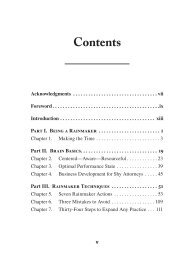(Bk Business) Carol Kinsey Goman Ph.D.-The Nonverbal Advantage_ Secrets and Science of Body Language at Work -Berrett-Koehler Publishers (2008)
Just
Just
Create successful ePaper yourself
Turn your PDF publications into a flip-book with our unique Google optimized e-Paper software.
Chapter 10: Selling Your Message without Saying a Word<br />
167<br />
research findings about the doctor/p<strong>at</strong>ient rel<strong>at</strong>ionship <strong>and</strong><br />
notice the similarities in your own line <strong>of</strong> work.<br />
<br />
<br />
<br />
<br />
<br />
<br />
P<strong>at</strong>ients report gre<strong>at</strong>er s<strong>at</strong>isfaction when doctors<br />
show nonverbal indic<strong>at</strong>ors <strong>of</strong> interest—such as leaning<br />
forward, nodding <strong>and</strong> gesturing more, establishing<br />
closer interpersonal distance, <strong>and</strong> spending less time<br />
looking <strong>at</strong> charts.<br />
A crucial point in the doctor/p<strong>at</strong>ient encounter is the<br />
physician’s first greeting. Does the physician show personal<br />
concern by <strong>of</strong>fering a h<strong>and</strong>shake, maintaining<br />
eye contact, <strong>and</strong> giving a warm smile?<br />
P<strong>at</strong>ients think they have spent more time with a doctor<br />
who sits down versus one who remains st<strong>and</strong>ing. Th<strong>at</strong>’s<br />
because a sitting position communic<strong>at</strong>es interest <strong>and</strong><br />
<strong>at</strong>tentiveness to wh<strong>at</strong> the p<strong>at</strong>ient is saying, whereas a<br />
st<strong>and</strong>ing position may give the impression <strong>of</strong> control<br />
<strong>and</strong> an authorit<strong>at</strong>ive <strong>at</strong>titude.<br />
Doctors who look <strong>at</strong> their w<strong>at</strong>ches, drum their fingers,<br />
<strong>and</strong> look toward the door give the impression th<strong>at</strong><br />
they’re in a hurry or don’t have time for the p<strong>at</strong>ient.<br />
If a doctor shies away from the p<strong>at</strong>ient, doesn’t lean<br />
toward the p<strong>at</strong>ient, or seems uncomfortable in the session,<br />
the body language communic<strong>at</strong>es a problem th<strong>at</strong><br />
is sometimes not even st<strong>at</strong>ed.<br />
Poor body language in emotionally charged situ<strong>at</strong>ions<br />
can lead to a breakdown in the doctor/p<strong>at</strong>ient<br />
rel<strong>at</strong>ionship.<br />
It’s also interesting to note th<strong>at</strong> doctors who are competent<br />
with nonverbal communic<strong>at</strong>ion have higher p<strong>at</strong>ient s<strong>at</strong>isfaction<br />
scores. <strong>The</strong>y are r<strong>at</strong>ed as more caring. And, whether<br />
you are a physician, salesperson, teacher, coach, negoti<strong>at</strong>or,




